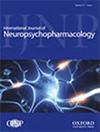Placebo Effects Are Small on Average in the 7.5% CO2 Inhalational Model of Generalised Anxiety
IF 3.7
2区 医学
Q1 CLINICAL NEUROLOGY
引用次数: 0
Abstract
Background Anxiety disorders are highly prevalent and socio-economically costly. Novel pharmacological treatments for these disorders are needed as many patients do not respond to current agents or experience unwanted side-effects. However, a barrier to treatment development is the variable and large placebo response rate seen in trials of novel anxiolytics. Despite this, the mechanisms that drive placebo responses in anxiety disorders have been little investigated, possibly due to low availability of convenient experimental paradigms. We aimed to develop and test a novel protocol for inducing placebo anxiolysis in the 7.5% CO2 inhalational model of generalised anxiety in healthy volunteers. Methods Following a baseline 20-minute CO2 challenge, 32 healthy volunteers were administered a placebo intranasal spray labelled as either the anxiolytic ‘lorazepam’ or ‘saline’. Following this, participants surreptitiously underwent a 20-minute inhalation of normal air. Post-conditioning, a second dose of the placebo was administered, after which participants completed another CO2 challenge. Results Participants administered sham ‘lorazepam’ reported significant positive expectations of reduced anxiety (p = 0.001) but there was no group-level placebo effect on anxiety following CO2 challenge post-conditioning (p’s > 0.350). Surprisingly, we found many participants exhibited unexpected worsening of anxiety, despite positive expectations. Conclusions Contrary to our hypothesis, our novel paradigm did not induce a placebo response, on average. It is possible that effects of 7.5% CO2 inhalation on prefrontal cortex function, or behaviour in line with a Bayesian predictive coding framework, attenuated the effect of expectations on subsequent placebo response. Future studies are needed to explore these possibilities.在 7.5% 二氧化碳吸入性广泛焦虑模型中,安慰剂效应平均较小
背景焦虑症发病率高,社会经济代价高昂。由于许多患者对目前的药物没有反应或出现不必要的副作用,因此需要对这些疾病进行新的药物治疗。然而,在新型抗焦虑药的试验中,安慰剂反应率不尽相同,且幅度较大,这是治疗方法开发的一个障碍。尽管如此,可能由于缺乏方便的实验范例,对焦虑症安慰剂反应的驱动机制研究甚少。我们的目的是开发并测试一种新的方案,用于在健康志愿者中通过吸入 7.5% 二氧化碳诱导安慰剂抗焦虑模型。方法 对 32 名健康志愿者进行 20 分钟的二氧化碳基线挑战后,给他们鼻内喷洒一种安慰剂,标注为抗焦虑药 "劳拉西泮 "或 "生理盐水"。随后,参与者偷偷吸入正常空气 20 分钟。调节后,再给参与者注射第二剂安慰剂,然后再完成一次二氧化碳挑战。结果 被施用假 "劳拉西泮 "的受试者对焦虑减少有显著的积极预期(p = 0.001),但在二氧化碳挑战调节后,安慰剂对焦虑没有群体水平的影响(p's > 0.350)。出乎意料的是,我们发现许多参与者表现出了意想不到的焦虑恶化,尽管他们有积极的预期。结论 与我们的假设相反,我们的新范例并没有诱导出平均的安慰剂反应。有可能是吸入 7.5% 二氧化碳对前额叶皮层功能的影响或符合贝叶斯预测编码框架的行为,削弱了预期对随后安慰剂反应的影响。未来的研究需要探索这些可能性。
本文章由计算机程序翻译,如有差异,请以英文原文为准。
求助全文
约1分钟内获得全文
求助全文
来源期刊
CiteScore
8.40
自引率
2.10%
发文量
230
审稿时长
4-8 weeks
期刊介绍:
The central focus of the journal is on research that advances understanding of existing and new neuropsychopharmacological agents including their mode of action and clinical application or provides insights into the biological basis of psychiatric disorders and thereby advances their pharmacological treatment. Such research may derive from the full spectrum of biological and psychological fields of inquiry encompassing classical and novel techniques in neuropsychopharmacology as well as strategies such as neuroimaging, genetics, psychoneuroendocrinology and neuropsychology.

 求助内容:
求助内容: 应助结果提醒方式:
应助结果提醒方式:


